Click HERE to watch this video on YouTube
Seasoning is a crucial step for any carbon steel or cast iron wok. Here is an easy step-by-step guide on how to season a wok using just a few simple ingredients.
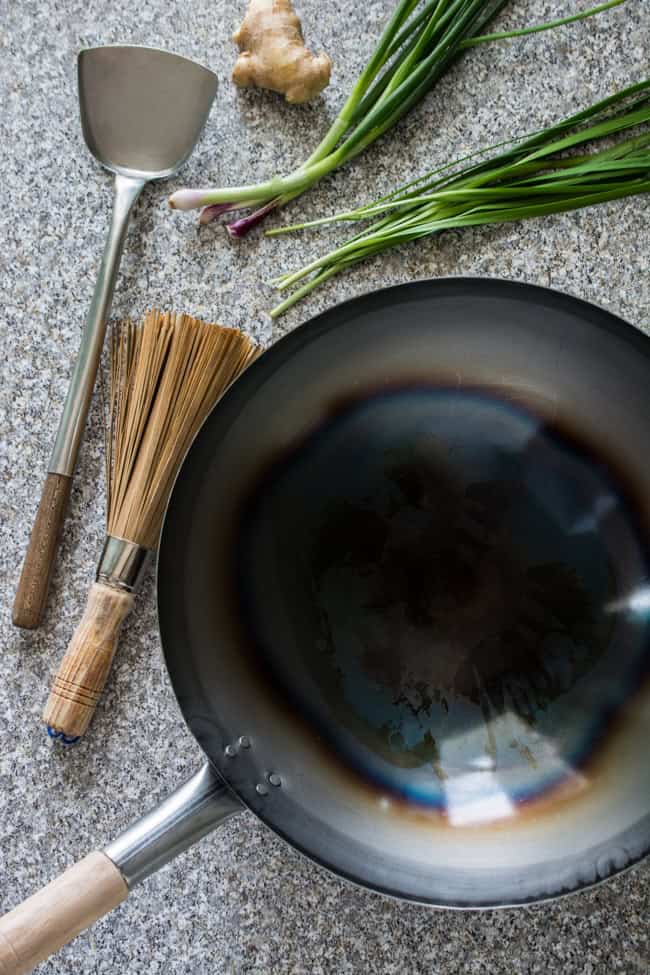
I purchased my very first wok after moving from Malaysia to the US to attend university in the year 2000. After washing my brand new carbon steel wok for the first time, it was covered in rust.
I was so confused because my Mum's and grandmother's woks never ever did that!
I went back to the Asian supermarket thinking I had to buy a new wok because I ruined it. The store owner remembered my previous purchase and refused to sell me a new wok! He told me to go home, scrub out the rust, and season the wok.
I had no idea how to season a wok so I called my Mum to ask for her advice. I then learned that her wok never rusted because it was so well seasoned from many years of regular use.
With proper seasoning and care, a wok can last for a very very long time. It is one of the most versatile tools in any kitchen. It is my hope that this step-by-step guide will help you understand how easy it is to season and maintain a wok; thus encouraging you to utilize your wok more.
Why season a wok?
Seasoning a wok introduces a layer of oil to the wok's surface to prevent the metal from rusting, and also to prevent food from sticking to the wok. The more you use your wok, the more seasoned it becomes.
The color of the wok will become very dark, and the seasoning (also known as "patina") will eventually create a naturally non-stick surface.
This patina will impart some subtle but awesome flavors (what we call wok hei - "the breath of the wok") in each dish that you stir-fry.
What you'll need:
- A carbon steel or cast iron wok (either brand new, or due for re-seasoning)
- Liquid dish soap
- Scouring pad or stainless steel scrubber
- 3 tablespoons of cooking oil (must be high smoke point oil; I recommend peanut oil or grapeseed oil)
- 2-inch piece of ginger (thinly sliced)
- 1 ½ cups chopped scallions or garlic chives (or a mixture of both; cut into approximately 1-inch pieces)
- 2 - 3 paper towels
Step 1: Wash the wok thoroughly using a scouring pad or a stainless steel scrubber and a generous amount of dish soap.
All brand new cast iron and carbon steel woks have a layer of chemical or oils to prevent them from rusting before they are purchased.
I recommend scrubbing the wok at least 2 - 3 times to get rid of any factory chemical or oil residue as you would not want any of that in your food!

Step 2: After rinsing all the soap off the wok, let it drip dry for a few seconds, then place it on your stove over medium heat. This will dry the wok and prep it for its first seasoning! After just a few moments, the bottom of the wok will start to turn to a dark color with a blue-ish hue.
Don't be alarmed - this is totally normal! The more you use it, the darker the wok will become.

Step 3: As soon as you see the wok start to smoke just a little, add about 2 tablespoons of cooking oil. You can use any oil with a high smoke point. I recommend peanut oil or grapeseed oil.
Use your wok spatula to spread the oil around just the bottom part of the wok, then add sliced ginger (2-inch piece, sliced thinly), and about 1 ½ cups of chopped scallions or garlic chives (or a combination of both).
The purpose of adding these ingredients is two-fold: Not only do they add a wonderful aroma and patina to the wok, they also help to spread the oil evenly over the (inside) surface of the wok.

Step 4: Use your wok spatula to move the scallions or chives and ginger around the entire surface of the wok. You don't have to stir too vigorously but somewhat continuously to prevent them from burning too quickly.

Step 5: As soon as the vegetables have started to char just a little, remove them from the wok and discard.
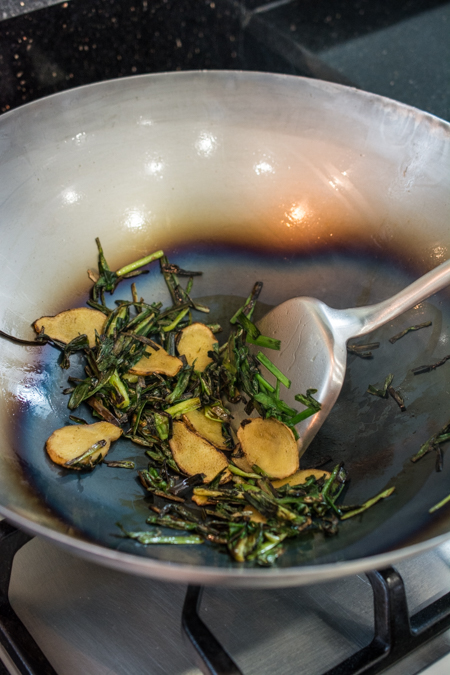
Step 6: Rinse the wok under running water. Use a wok brush, or stainless steel scrubber to remove the food residue from the wok. Do NOT use soap!!
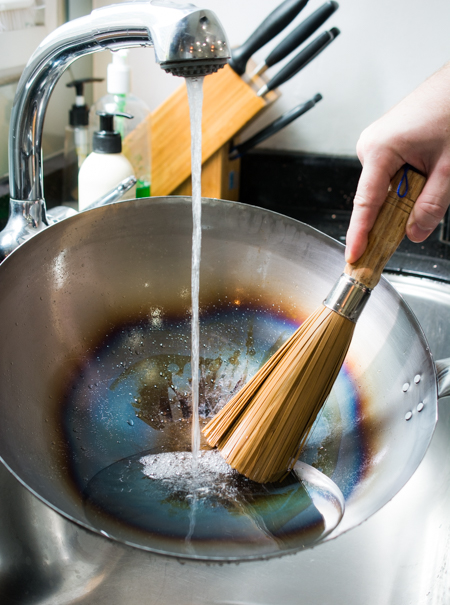
Step 7: Allow the wok to drip dry, then return it to the stove over medium heat. As soon as the wok is completely dry, turn off the heat.
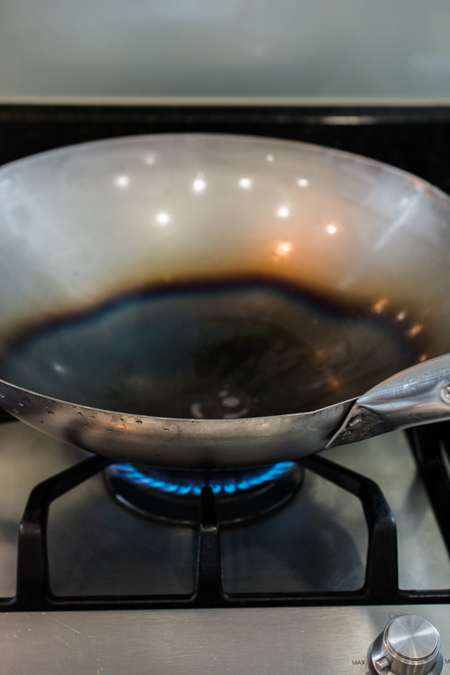
Step 8: When the wok has cooled a little, pour about a tablespoon of cooking oil into the wok, then gently and slowly spread the oil all over the inside surface of the wok using 2 - 3 folded paper towels. Please remember to do this very slowly and gently to prevent the hot oil from splashing and burning your fingers!

Here's a before-and-after comparison of my wok being seasoned for the first time:
Would you like to save this?

That's it! You've seasoned your brand new wok! You're ready to stir-fry! 🙂
Maintaining Your Wok
Avoid cooking acidic foods (like tomatoes), poaching or steaming foods in your brand new wok until it is more seasoned. This will strip out the patina you worked so hard to develop! If you absolutely have to, you can re-season the wok using the above steps.
Do NOT use soap unless absolutely necessary (for example, if you cooked a spicy dish and want to remove the chili oil). This will also remove the seasoning very quickly.
After each use, simply repeat steps 6 through 8 to clean your wok.
It does take a long time for the wok to develop a nice patina, even with regular use, so don't be discouraged if you don't see much change in your wok for a while. Over time and with regular use, your wok will be so seasoned that you will not need to do Step 8 (applying the coat of oil after the wok dries)!
I hope this guide has been helpful to you. Please feel free to reach out to me if you have any questions or if you have any tips you would like to share!
Happy cooking! 🙂
PS - Check out my cookbook (The Healthy Wok) to get some stir-fry recipes to try in your new wok!
UPDATE: Here's a photo of this same wok exactly 9 months after its first seasoning (2 - 3 times per week usage)

New to Asian Cooking? Check out these resources:
- My collection of Asian recipes
- An easy guide on how to navigate your local Asian supermarket like a pro!
- My top 10 Asian Kitchen Essentials
- A shopping list of Asian Pantry Staples
A stainless steel wok should not be seasoned in the same way you would season a cast iron or carbon steel wok. The only reason to season a stainless steel wok is to ensure that the food does not stick; it won't develop a patina like cast iron and carbon steel woks do.
To "season" a stainless steel wok, just add oil and turn the heat to high till it starts to smoke, turn the heat down to low for about a minute, turn the heat back up, then start cooking.
You may need to re-season your wok a few times, especially when it is newer. This will depend on how often and what you cook in your wok.
For example, it will likely need to be re-seasoned if you used your wok to poach or steam food, or if you notice that it is not as non-stick as it used to be. Over time, especially with frequent use, you will rarely need to re-season it.
You can use any type of neutral-tasting oil with a high smoke point, which means that it should be able to withstand high temperatures. Some great options include peanut oil, grapeseed oil, and pork fat/lard (hello, flavor!)





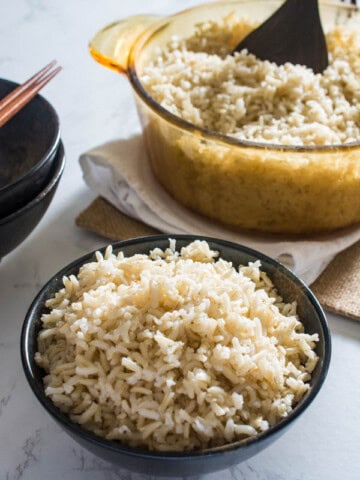
Nick says
Thanks for this informative post! I have recently gotten into cooking with carbon steel and I am stuck on the issue of acids and wok seasoning. I have noticed that many traditional stir frys include vinegar in their sauce, which is an acid!
I would like to cook stir frys using my wok. If I wait to use vinegar until my wok is very well seasoned, add the vinegar as late as possible, mix it with other ingredients first, and rinse out the pan right away, will that be enough? Or should I use another pan entirely for mixing it together?
Char says
Hi Nick! The amount of vinegar in most sauces is quite minimal so I wouldn't stress about that. In most cases, you would add the sauce towards the end anyways. If you find that it affects the wok's ability to create that nice patina, just re-season it as often as you need to. Hope that helps! Happy cooking!
Cherie says
Thank you for the great information. I just finished seasoning my new wok and I am excited to start using it.
Char says
You're so welcome, Cherie! Enjoy your new wok! 🙂
James says
Thank you so much for this post! I had a question: my wok did not change color at all over heat, does this mean I didn't do it right, or that I have the wrong kind of wok?
Char says
Hi James! Do you know what material is your wok made of? I wouldn't worry about the color not changing. However, if you have a stainless steel wok, you do not need to season it in this way. This seasoning method is only for cast iron and carbon steel woks. Feel free to reach out if you have any further questions!
Bob says
Is there a difference in the taste of food prepared using a:
1. carbon steel wok *seasoned),
2. cast iron wok (seasoned), or
3. stainless steel wok?
Bob
Char says
Hi Bob! The difference in flavor, if any, will be super subtle and will also depend on how well your carbon steel/cast iron wok is seasoned, and also what foods you had cooked in those woks to season them. I hope this helps!
Roy says
hello . thank you for on how to season a wok . very good information .
Char says
You're very welcome, Roy!